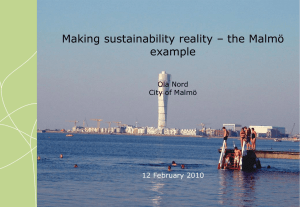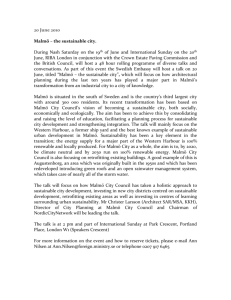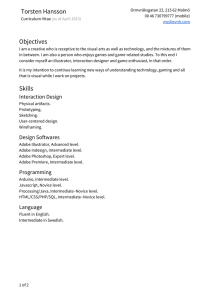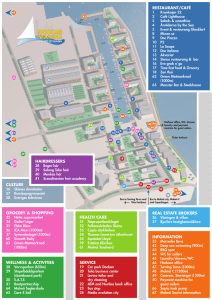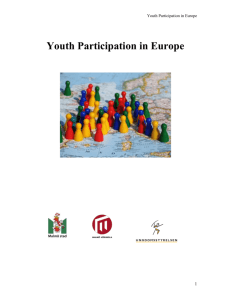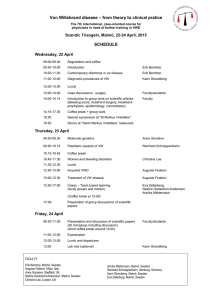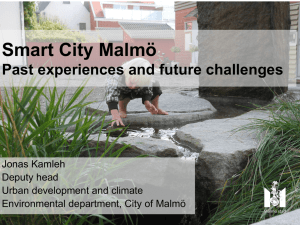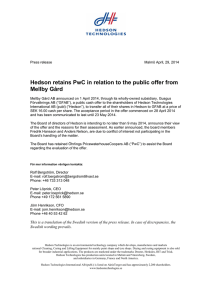Björgvinsson m fl: Participatory design and “democratizing innovation”
advertisement
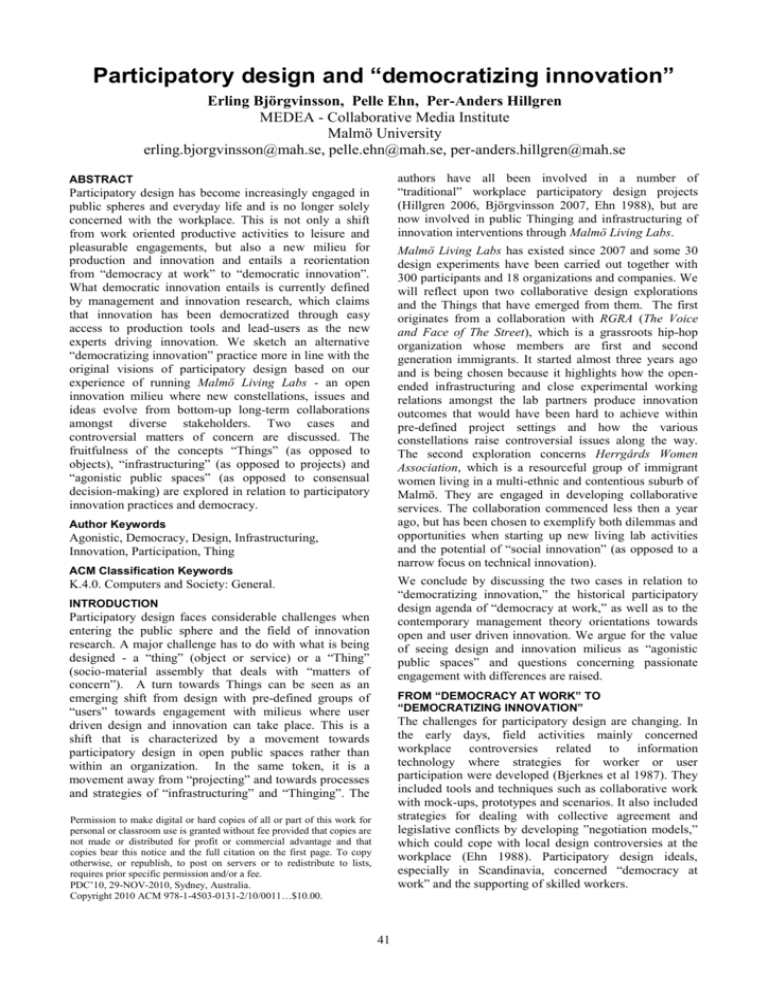
Participatory design and “democratizing innovation” Erling Björgvinsson, Pelle Ehn, Per-Anders Hillgren MEDEA - Collaborative Media Institute Malmö University erling.bjorgvinsson@mah.se, pelle.ehn@mah.se, per-anders.hillgren@mah.se authors have all been involved in a number of “traditional” workplace participatory design projects (Hillgren 2006, Björgvinsson 2007, Ehn 1988), but are now involved in public Thinging and infrastructuring of innovation interventions through Malmö Living Labs. ABSTRACT Participatory design has become increasingly engaged in public spheres and everyday life and is no longer solely concerned with the workplace. This is not only a shift from work oriented productive activities to leisure and pleasurable engagements, but also a new milieu for production and innovation and entails a reorientation from “democracy at work” to “democratic innovation”. What democratic innovation entails is currently defined by management and innovation research, which claims that innovation has been democratized through easy access to production tools and lead-users as the new experts driving innovation. We sketch an alternative “democratizing innovation” practice more in line with the original visions of participatory design based on our experience of running Malmö Living Labs - an open innovation milieu where new constellations, issues and ideas evolve from bottom-up long-term collaborations amongst diverse stakeholders. Two cases and controversial matters of concern are discussed. The fruitfulness of the concepts “Things” (as opposed to objects), “infrastructuring” (as opposed to projects) and “agonistic public spaces” (as opposed to consensual decision-making) are explored in relation to participatory innovation practices and democracy. Malmö Living Labs has existed since 2007 and some 30 design experiments have been carried out together with 300 participants and 18 organizations and companies. We will reflect upon two collaborative design explorations and the Things that have emerged from them. The first originates from a collaboration with RGRA (The Voice and Face of The Street), which is a grassroots hip-hop organization whose members are first and second generation immigrants. It started almost three years ago and is being chosen because it highlights how the openended infrastructuring and close experimental working relations amongst the lab partners produce innovation outcomes that would have been hard to achieve within pre-defined project settings and how the various constellations raise controversial issues along the way. The second exploration concerns Herrgårds Women Association, which is a resourceful group of immigrant women living in a multi-ethnic and contentious suburb of Malmö. They are engaged in developing collaborative services. The collaboration commenced less then a year ago, but has been chosen to exemplify both dilemmas and opportunities when starting up new living lab activities and the potential of “social innovation” (as opposed to a narrow focus on technical innovation). Author Keywords Agonistic, Democracy, Design, Infrastructuring, Innovation, Participation, Thing ACM Classification Keywords We conclude by discussing the two cases in relation to “democratizing innovation,” the historical participatory design agenda of “democracy at work,” as well as to the contemporary management theory orientations towards open and user driven innovation. We argue for the value of seeing design and innovation milieus as “agonistic public spaces” and questions concerning passionate engagement with differences are raised. K.4.0. Computers and Society: General. INTRODUCTION Participatory design faces considerable challenges when entering the public sphere and the field of innovation research. A major challenge has to do with what is being designed - a “thing” (object or service) or a “Thing” (socio-material assembly that deals with “matters of concern”). A turn towards Things can be seen as an emerging shift from design with pre-defined groups of “users” towards engagement with milieus where user driven design and innovation can take place. This is a shift that is characterized by a movement towards participatory design in open public spaces rather than within an organization. In the same token, it is a movement away from “projecting” and towards processes and strategies of “infrastructuring” and “Thinging”. The FROM “DEMOCRACY AT WORK” TO “DEMOCRATIZING INNOVATION” The challenges for participatory design are changing. In the early days, field activities mainly concerned workplace controversies related to information technology where strategies for worker or user participation were developed (Bjerknes et al 1987). They included tools and techniques such as collaborative work with mock-ups, prototypes and scenarios. It also included strategies for dealing with collective agreement and legislative conflicts by developing ”negotiation models,” which could cope with local design controversies at the workplace (Ehn 1988). Participatory design ideals, especially in Scandinavia, concerned “democracy at work” and the supporting of skilled workers. Permission to make digital or hard copies of all or part of this work for personal or classroom use is granted without fee provided that copies are not made or distributed for profit or commercial advantage and that copies bear this notice and the full citation on the first page. To copy otherwise, or republish, to post on servers or to redistribute to lists, requires prior specific permission and/or a fee. PDC‟10, 29-NOV-2010, Sydney, Australia. Copyright 2010 ACM 978-1-4503-0131-2/10/0011…$10.00. 41 general market. For von Hippel, democratization of innovation becomes a competitive elite market democracy, which is an oxymoron. The main picture from von Hippel‟s “lead users” to Richard Florida‟s hyped “creative class” (Florida 2002) is that of the new experts and their smart products. Four decades later, the tools, and maybe also the strategies, have become much more sophisticated. At the workplace, new media are seen as much less threatening and managerial strategies have changed considerably. Whether there is more democracy at work is open to interpretation. What we clearly can see today is a design reorientation towards everyday life and the public sphere. But this does not necessarily mean a turn away from productive design activities, which are now often seen as innovations. Many cities have embraced Florida‟s notion of the creative class, with the noteworthy exception of Toronto, and public discourse and policies around research funding privilege so called innovative environments, initiatives, and professionals. Such innovation systems are typically built around the “Triple Helix” model for collaborative knowledge production, suggesting (regional) hybrid organizations like incubators in the intersection between university, industry and the public sphere (Etzkowitz and Leydsdorff 2000). This reorientation stems from the condition that new media has entered every nook of our lives, that design and innovation activities have become distributed across contexts and competences often blurring the borders between citizens, private companies, the public domain and academia. This reorientation is also due to the condition that user driven innovation has become widespread. Despite all their merits, innovation within such discourses is interpreted largely as producing what Barry calls universal novelty products, that can be marketed rather than judging innovation by the degree it opens up for possibilities and questions (Barry 2001). The underlying rhetoric often being that the market economy, which increasingly thrives on the speed of producing novelty products, is a precondition for democracy (Mouffe 1993). Defining what innovations is, who innovates, where and under what conditions innovation occurs, is therefore an important battleground within society today. Controversies around new media and innovation have not evaporated. Is there a research perspective on democratizing innovation more in line with the values that once guided participatory design? With Malmö Living Labs as a participatory design and interventionist innovation milieu we have concretely set out to explore this arena of “democratizing innovation”. This change demands that participatory design research consider how it relates to ideas and initiatives that concern user driven design and innovation in other research traditions. In management science traditions, user driven innovation is often associated with “open innovation” which introduced a new innovation model that explore collaboration across company borders; opening the generation of ideas from only inside the firm and revising the concept of innovation and its locus (Chesbrough, 2003). This open innovation model, as revised by Pralahad, points out major challenges that have emerged in the new business environment. One such challenge is that a company product-centric view is being replaced by the “co-creation” of value. While the view of the individual innovator prevails, it is becoming increasingly challenged by the collaborative business environment as a basis for innovation (Pralahad and Krishnan 2008). ”Crowd-sourcing” is, given the potential of new media, one of the new ways for companies to innovate by harnessing “the wisdom of crowds” (Surowiecki 2004) and ”lead users” (von Hippel 2005), at the center of attention for user driven innovation. But what perspectives do they have on democracy, innovation, participation, and what is to be designed? “LIVING LABS” AS INNOVATION ENVIRONMENTS When developing Malmö Living Labs, we aim to establish long-term relationships, to allow participants to become active co-creators, and to make it so that what is being designed enters their real life context. This is in contrast to many co-creation approaches and living lab initiatives where users often are seen as participants to sample or simply involved in a design processes to help elicit user needs. A comprehensive analysis is beyond the scope of this paper and there are opposing views within the tradition. However, one of the most influential views on userdriven innovation, in this tradition, is Eric von Hippel‟s notion of lead-user innovation and democracy as put forward in Democratizing Innovation (von Hippel 2005). He argues that innovation has become democratized because information and the means of productions – cheaper and more easily handled tools - have become more readily available leading to more individuals having the ability to innovate. Innovation is thus defined as making discrete objects or products. Democracy is equated and delimited to having increased access to information and tools to make more products. And although he acknowledges that users are active creators, this rings true only to a small elite of lead-users or domain experts who benefit from increased access to information and means of production. The term “leadusers” points towards individuals that are ahead of the There are more than two hundred innovation milieus within the European Living Lab initiatives. How the labs operate varies, but they share some common characteristics. They all argue that the labs are situated in real world environments, are user-driven, and collaborate with research organizations, companies, and public and civic sectors with the aim to collaboratively develop new services and products. Living labs emerged as a response to innovation environments that were too closed, which often resulted in failure to innovate, partly because of limited and late interaction with potential markets (Stålbröst 2008). Foregrounding the importance of users‟ role and real life contexts in innovation has thus been central to the living labs approach. Common to many of these approaches is, however, a product-centric view rather than a focus on socio-material working relations. Buur and Mathews for example point out how von Hippel 42 focuses too strongly on technology and too little on the match between people, technology and context (Buur and Mathews 2008). place, to a meaning of “an entity of matter” or a material “object”. Things in ancient Nordic and Germanic societies were originally assemblies, rituals and places where disputes were dealt with and political decisions made. Latour has called for a contemporary “thing philosophy” and to make things public (Latour and Weibel 2005). Things are not cut of from human relations, but rather socio-material “collectives of humans and non-humans” through whom “matters of concern” or controversies are handled. (At the same time, a designed object/thing (“an entity of matter”) is potentially a Thing made public, since once it is delivered to its participants, it becomes a matter of concern for them with new possibilities of interaction). Closer to our approach is the notion of design labs (Binder 2007) that foregrounds active user participation. What they put forward is that we can see such labs as collaborative learning environments where a chain of translations occurs across organizational and community boundaries (Binder 2007). Design for social innovation is, however, the view on innovation that has had the strongest impact on Malmö Living Labs. Social innovations can be products or services just like any innovation, but they can also be a principle, an idea, a piece of legislation, a social movement, an intervention, or some combination of them. The key aspect is its capacity to simultaneously meet social needs and create new social relations. The Young Foundation in the U.K. has been a major player in developing the social innovation perspective in theory and practice (Murray et al 2010). Italian designer and researcher Ezio Manzini and the international group around him have been main drivers in spreading such design practices where new ideas emerge from a variety of actors directly involved in the problems to be solved. The actors included end users, grass roots designers, technicians and entrepreneurs, local institutions and civil society organizations. In this perspective, design is no longer just a tool for the development of functional innovative consumer products, but is increasingly seen as a process for radical change in developing services, systems, and environments, which support more sustainable lifestyles and consumption habits. A main concept for Manzini and his colleagues (Jégou & Manzini 2008) is ”collaborative services”. The role of the designer is initially to support the development of new concepts and later to make them attainable so they can result in „social‟ enterprises. Hence, we find it constructive to think of innovation milieus like Malmö Living Labs as Things, especially if aspects of democratization are at stake. This helps to explore these innovation environments as socio-material frames for “matters of concerns” and the alignment of controversies, ready for unexpected use, opening up new ways of thinking and behaving. It also helps in inquiring into how designers may act in a public space that permits heterogeneity of perspectives to engage in alignments of their conflicting matters of concern. Infrastructuring is the second related concept we find powerful. A central issue that we have faced when establishing Malmö Living Labs was first, where to locate innovation and second, what type of infrastructure is suitable to ”social innovation”. Infrastructure is a central issue since innovation today, to a large degree, demands extensive collaboration over time and among many stakeholders. But this demands, as Star argues, that we see infrastructure not as a substrate that other actions can run on top of, but rather an ongoing alignment between contexts (Ruhleder and Star 1996). Similarly Suchman (2002) argues that we need to get away from viewing things as discrete objects and as networks of devices but instead start viewing design work and technological development “as entry into the networks of working relations – including both contests and alliances – that make technical systems possible” (Suchman 2002 p. 92). This is hard design work where various contexts or practices and technologies concurrently undergo change and therefore demand continuous infrastructuring and aligning of partly conflicting interests (Ruhleder and Star 1996). THINGS AND INFRASTRUCTURING Before looking closer at some Malmö Living Labs experiences, we will first introduce the concepts of Things and infrastructuring, as they suggest how we can go beyond thinking in terms of products towards a view of innovation that embraces working relations where questions and possibilities can be raised. The main approach in participatory design research has been to organize projects with identifiable stakeholders within an organization, paying attention to power relations and the empowerment of resources to weak and marginalized groups. This has been the main rationale for participatory design in contributing to “democracy at work”. However, innovation today is rather heterogeneous, partly open and public, engaging users and other stakeholders across organizational and community borders. To capture this change we think it may be useful to shift frame of reference from design projects to design Things (Ehn 2008, Binder et al forthcoming). Hence infrastructuring can be seen as an ongoing process and should not be seen as being delimited to a design project phase in the development of a freestanding system. Infrastructuring entangles and intertwines potentially controversial “a priori infrastructure activities” (like selection, design, development, deployment, and enactment), with “everyday design activities in actual use” (like mediation, interpretation and articulation), as well as “design in use” (like adaptation, appropriation, tailoring, re-design and maintenance) (Karasti and Baker 2008, Twidale and Floyd 2008, Pipek and Wulf 2009). The etymology of the English word “Thing” reveals a journey from meaning an “assembly” around “matters of concern”, taking place at a certain time and at a certain As a consequence, what needs to be established is Things as long-term relationships through artful integration, in 43 social and technical platforms and integrated with the overall innovation system in the city and region. which continuous co-creation can be realized, in which those involved pay attention to and work with how technology connects to wider systems of socio-material relation in the form of collective interweaving of people, objects and processes (Suchman 2002). “The Stage” is situated in the vibrant club, music, theatre and sub-culture district in the city and focuses on cultural production and cross-media. “The Neighborhood” lab is located in the contentious multi-ethnic suburbs Rosengård and Fosie and focuses on urban development, collaborative services and social media. Finally, “The Factory”, still “under construction”, is a lab housed in a new cultural meeting place in the heart of the new media cluster in the city and functions as a prototyping lab. MALMÖ LIVING LABS Ten years ago Malmö, with some 300.000 inhabitants in the south of Sweden, was a dormant city. All major industries had disappeared. Today it is a vibrant university city with an increasing number of small and medium sized IT, media and design companies and a lively cultural scene. It is also a segregated city that has the highest number of immigrants in Sweden from the Baltic region, Iraq, Afghanistan, and various African countries. How bridges may be built between dispersed groups, communities and competences is thus a central issue in the city. What could democratizing innovation mean under such urban conditions? This is what we have set out to explore with Malmö Living Labs. Clearly, the picture given above says very little of the actual “Thinging” and “infrastructuring” that is going on within Malmö Living Labs, nor of what specific matters of concern and controversies are at stake. In the next section we will make a more detailed account from two of the innovation milieus and focus on matters of concerns and controversies in two stories of grassroots engagement in the labs. With Malmö Living Labs as an interventionist actionresearch-oriented approach, we are exploring innovation as a historically and geographically located phenomena (rather than as a universal and ahistorical one). As interventions in the city of Malmö, we explore whether innovation in practice can be about opening-up spaces for questions and possibilities (rather than seeing innovation purely as producing novelty products to be marketed). At the same time, we attempt to connect disparate parts of the city and to build bridges between groups and competences. Hence, we explore whether innovation must be delimited to specific privileged societal groups, experts and lead-users or if a more democratic approach is possible. RGRA AND THE COLLABORATIVE CULTURAL LAB: THINGS AND CONTROVERSES I We shall start a more detailed accounts on Things and controversies in Malmö Living Labs with an example taken from the collaborative culture production lab, the Stage, since it was the first lab (established 2007), and has been a prototyping experience for the two latter collaborating labs (established late 2009 and 2010). We began by establishing a network of actors consisting of cultural producers, grassroots organizations, as well as IT and media companies. The aim was to explore how new media practices could grow out of ongoing cultural productions and grassroots activities centred around the arts and performance centre Inkonst. This functioned as a cultural and geographic bridge between the different parts of the city. We have, since 2007, been engaged in infrastructuring activities, using Malmö Living Labs as a vehicle to design Things and to align disparate “matters of concern” and controversies. This involved establishing a milieu where an open-ended infrastructure for innovations allowed a continuous match-making process and quick contextual experiments. During the two first years, this was done in a smaller scale with a focus on developing a new media service that in different ways enhance cultural activities and practices [www.malmolivinglab.se]. Although initiatives and ideas could come from any lab partner, we have focused on enhancing existing cultural practices by exploring various emergent “innovation” practices without a priori ideas regarding what lab partners should collaborate on, which technologies should be used, nor how innovation practices should be organized. Through Inkonst we got engaged with RGRA, a grassroots hip-hop youth organisation whose members are first and second generation immigrants living in the suburbs of Malmö. These teenagers travel geographically and culturally between the periphery and the centre of Malmö and Swedish society. Many of them feel marginalized and do not have the opportunity to express themselves on their own terms in the public sphere, whether this be in the urban environment or in the Swedish media landscape. (Mainstream media has one-sidedly depicted their suburbs unfavourably with the result that many of the teenagers feel stigmatized). Central to RGRA’s approach are multi-ethnic encounters through cultural activities. Issues of integration are not explicitly on their agenda, but indirectly addressed, as they rap, dance, and make graffiti. Many of the teenagers are creative and skilled rappers and beat makers. During the last year, we have, through major research grants, been able to scale up this environment. In order to maintain close working relations and trust we have decided to launch three small collaborating labs rather than one large lab. As mentioned, the city of Malmö is characterized by its multi- ethnicity, cultural production, youth culture and new media industry. This is also the rational behind the content orientation and cultural and geographic position for the three collaborating living labs innovation milieus: “The Stage”, “The Neighborhood” and “The Factory”. Though different in orientation and geographic locations, these three living labs are all founded on shared ideas and values. They are all based on user-driven design and innovation activities, growing out of social movements. At the same time they are planned as open innovation 44 Being seen: street journalism – mainstream media of Malmö‟s bus routes, also agreed to participate and give access to their busses. Initial meetings and workshops with RGRA revealed that they wanted to explore how their presence in the urban landscape and the current media landscape could be enhanced. Their ambition was to run an online Street Magazine on their webpage. Prior to this, they had made some videos that had been published on the web. We introduced them to a variety of new communication possibilities that could enhance their practice, some of which came from our business partners. The general outcome of the experiments was interesting, given the constellation of partners with disparate matters of concern. RGRA saw the potential of getting access to a new space where they could distribute their music and that would make them more visible in the city. The bus company saw a potentially new commuter service beyond traditional transportation. They suggested quizzes for commuters and could also see the potential of distracting teenagers from destroying the bus-seats. Do-Fi saw the potential of developing a new product and new services in collaboration with the company Epsilon Embedded Systems. The researchers saw the potential of developing a new research project focusing on place-specific media. The network of actors applied for research funding to develop a working prototype, which was granted, and led to BluePromo, a research project on developing a portable low-cost media hub. More than two years down the road, what started out as broad open-ended explorations has resulted in various constellations and Things that have explored how RGRA could engage in street journalism through mobile video broadcasting dealing with dilemmas such as how professional media and grassroots media can collaborate and how to mediate a talent competition, aimed to let different parts of the city and different musical traditions meet. Urban presence: legitimacy and visibility ”Matters of concern” has centred on how RGRA‟s presence in the urban environment could become more legitimate and visible. These urban media explorations, whether short or longer, have revealed various controversies as we (in different constellations and Things) have looked into how the youngsters could feel at home and appropriate commercial spaces, how they could become more visible in semi-public spaces by spreading their music on buses, and finally, how the stigmatization of their neighbourhoods could be diminished through urban gaming. The issue of feeling at home and feeling free to appropriate commercial spaces was explored through Barcode Beats; an instrument developed by our students in collaboration with RGRA. With the consent of the owner of Malmö's biggest grocery store, a live performance took place, where the teenagers jammed by scanning grocery barcodes that were converted into unique hiphop loops that resonated through the store. This playful performance or Thing should be seen in the context that many Arab immigrants in Malmö feel that they have to behave more exemplary in public spaces than native Swedes do. In fact, they feel constantly surveilled while shopping (Sixtensson 2009). Figure 1. A passenger is listening to the song he downloaded to his mobile phone. In one sense, the Bluetooth bus undertaking can be seen as just another experiment, but that does not tell the whole story. It was also a Thing. The experiment revealed not only the possibility of aligning different matters of concern, but also controversies and conflicts. One controversy concerned the constellation of partners. RGRA had split emotions on whether they should collaborate with Veolia, because the international branch of the company is engaged in building transportation infrastructure in East Jerusalem, which is perceived by many Arabs to be Israeli-occupied Palestinian territory. At the same time, they saw that they could gain financially from participating and benefit from having access to the network of actors. RGRA ended up carrying on with the condition that their and Veolia‟s logotypes would not appear next to each other in any press material. They were foremost collaborating with the researchers and the IT-company and only indirectly with Veolia. The bus experiment generated also debates around immaterial rights; who could apply for patents, and who should gain financially if a new form of Bluetooth push technology were developed. Questions were also raised around what type of (media) space the interior of the bus could be. Could it be transformed into a more public and inclusive space or is it to remain an exclusive space leased out only to commercial actors as is the case today? Another more long-term engagement/exploration concerned how RGRA could become more visible in the urban environment. At an early workshop, between ourselves and RGRA, the idea came up that they could set up Bluetooth poles at strategic places or that Bluetooth senders could be placed in buses; transforming the bus company into a media provider (buses being a space where many youngsters spend up to two hours a day when commuting back and forth to school). Do-Fi, a company that specializes in developing Bluetooth services, was contacted. They saw potential in the idea and agreed to participate in setting up a first round of experiments. Two research colleagues with expertise in place-centric computing were engaged. Skånetrafiken, a company in charge of the public transport in the region, and Veolia, which operates many 45 Urban controversies be told. One of the first routes RGRA constructed was a murder mystery with a route going through a place where an actual fatal incident happened some years ago. Although they aimed for a new refreshed view of these parts of the city it seems like it will continue to be a mixed perspective. The Thing also raised concern about the role actors like RGRA can have when collaborating with companies or the university. We want to avoid a situation where they solely act as a “user group” that provide information and test results. To avoid this we will pay close attention to how they can be a part of potential future commercial services (e.g. constructing tourist routes through mobile games). Just as RGRA sensed that they should behave differently in public spaces and felt that they were to a large degree invisible in the urban environment they also felt that their neighbourhoods were largely unknown by youngsters living in other parts of the city. (A common view is that their neighbourhoods are dangerous). The open-ended structure of the Malmö Living Labs environment enabled a new Thing to emerge that could deal with this issue. Our open-ended structure allowed the assembly of RGRA, Do-Fi and the researchers, with the company Ozma Game Design and the city of Malmö. The strategy was to see how the mobile game platform UrbLove developed by Ozma could be used to create new experiences of RGRA‟s neighbourhoods. With the platform, participants could explore urban environments by solving ”text”-quizzes related to specific places. Combining their gaming platform with Do-Fi‟s Bluetooth technology also seemed fruitful since that would give the players the opportunity to download media files at specific spots when playing a game. In an initial experiment, youngsters from RGRA helped to develop a game path and produced media-related to their neighbourhood. We will return to further reflections on this case in the concluding discussion. For now we turn to the collaborative neighbourhood lab and immigrant women as social innovators. HERRGÅRDS WOMEN ASSOCIATION AND THE COLLABORATIVE NEIGHBORHOOD LAB: THINGS AND CONTROVERSIES II When we expanded the living lab our aim was to include a variety of stakeholders that had diverse backgrounds, skills and competencies and make sure that marginalized groups were included. One such marginalized group is the Herrgård’s Women Association (HWA), whose importance is acknowledged by many living in Rosengård, but has not been recognized by the city of Malmö. Five women started the association eight years ago because they felt excluded from the Swedish society. Its members include 200 women and 200 children. The members are primarily Afghan, but include Iranian, Iraqi and Bosnian nationalities. Many of the members are illiterate, have limited Swedish language skills and lack higher education. Central to the association‟s objectives is to raise the women‟s self-esteem. Other activities include study circles on sexual health and social issues such as honor-related violence, catering, sewing clothes, and crafting textiles and carpets. Recently they became engaged in the Neighbourhood Living Lab with the overall aim to explore how their skills and competencies can be acknowledged and valued by the Swedish society. Our strategy is to build a long-term relationship with them to understand the group and their ”matters of concern.” We have launched a series of experiments to explore how far they can go as a group by mainly enhancing ideas coming from them, but also by looking into how they can connect to the rest of the Malmö Living Labs environment. The women have suggested that they could help newly arrived refugee orphans, record and publish on the internet children stories that have been past-on to them, and cook and deliver food and repair curtains and carpets. Figure 2. RGRA youngsters explore a neighbourhood through a mobile game. The game path was tried out by other youngsters and revealed interesting outcomes. First of all, it seemed like a proper approach to explore unknown urban environments. It demonstrated how the game created a spontaneous interaction between the players and locals. Perhaps the most important outcome was that the participants expressed the need to continuously develop their own game paths, which was difficult with the present system. The experiment provided a base to get more research money to develop the platform into a more open and more easily administrated game engine. We are in the midst of creating a process where several more routes and narrative, having been constructed by RGRA, will allow not only youngsters, but all kinds of people (such as politicians and tourists) to participate in exploring their neighbourhoods. Small-scale experiments have been initiated to look at how these ideas can be realized. To explore their wish to help newly arrived refugee children, we have started collaborating with the health care company Attendo, which provides transit housing and care for newly arrived refugee orphans. The basic strategy is to explore how the women, who know Dari, Pashto and Arabic languages The most important matter of concern dealt with in this Thing regards what areas of the city were worth exposing positively. Another dilemma relates to what stories could 46 The organization is resourceful and capable, as these examples show, if given the opportunity. The group also has a large network, which is tight and were there is great amount of trust. They are also strong as a group. At the same time we can see several potential dilemmas. and culture, can offer a service to Attendo and the children. Working with refugee orphans is a delicate matter, since many of the children are depressed and will be moved to other countries. It is therefore important to proceed carefully in small steps and in close dialogue with Attendo by continuously evaluating how the service may affect the children. If the women carry out commercial services as members of a non-governmental organization, they do not compete under the same conditions as companies, because their taxes and social security fees are much lower. Will the trade unions, which were the starting point for Scandinavian participatory design, accuse the women for competing under unfair conditions that threatens regular jobs. Similar their potential interplay with society is largely unclear. Public authorities‟ views on what role NGO‟s could play vary considerably as well as what kind of infrastructure they think is needed to support them. The women‟s‟ view of public authorities and departments in the city of Malmö is mixed. They consider some civil servants to be helpful, but most often they feel that their initiatives are ignored. We hope that these experiments will help to uncover and make public what kind of collaborative potential could emerge between them and the city. In this process, we did not initiate new media into the experiment but rather started out by exploring in what way the children and women could meet. The first step was therefore to arrange an informal gathering at the HWA premises where the orphans from one of Attendo’s units, which houses 15-19 year old boys from Afghanistan, were served home cooked meals. The boys spontaneously started to sing Afghan songs and explained that they had not eaten Afghan-Iranian food since they started on their exile to Europe two years ago. They clearly expressed that they wished for a continuation. The women felt that the dinner arrangement had been successful, but were emotionally stirred. The next step was to offer a cooking class to the orphans, which was done in collaboration with our living lab partner Good World who provided access to their kitchen. Another dilemma concerns power relations within their families. The women state that their position within the family is complex. In some sense, they are strong, but upholding patriarchal traditions is also common in many Afghan and Iraqi families. The husband is seen as the family provider; he earns money and deals with politics and societal issues or similar matters of concern. However, most of these men have lost their authority on arriving in Sweden since many of them are unemployed. If the women‟s association develops into a successful business, it will give them a position in society that their husbands lack. The women are not sure how to handle this and traditionally their strategy has been to keep quiet about what they do so as to avoid trouble at home. We are planning to continue to explore what kind of relationships could be valuable for the orphans and the women. The recommendation from authorities is to keep a certain distance and avoid growing close relations, because most of the children live in transit and will soon lose contact as they are moved to other parts of Sweden or abroad. The authorities, however, still think that the women‟s engagement is of value, because they relate differently to the orphans than a Swedish civil servant. Attendo similarly states that the women have a unique position to provide temporary support and discuss with the orphans what it means to live in Sweden given their shared cultural background. We are now exploring how new media can enhance their relations. For example, whether video-recorded cooking instructions as well as encouragements and advices could be of value, or whether social media could be used for keeping contact? Another strand of this experiment with the HWA is to investigate how they can provide mixed services to companies. Just as with the refugee orphans, we invited the CEO of a company, which is a living lab business partner, to an informal meeting with the women where the CEO got the opportunity to taste their home cooked Afghan-Iranian food. She immediately saw that they could provide a service that went beyond traditional catering. Her idea was that the women could cook lunches at her company so that they could get to know each other and her employees could learn about their culture and how to cook Afghan-Iranian food. This could be expanded into a service geared at other small businesses where employees get a richer lunch experience that mixes lunching with cooking classes and cultural exchange. The women have also suggested that this service could include their textile and sewing skills where they, for example, could bring along portable sewing machines to make personalized laptop sleeves. Figure 3. Herrgårds Women Association hosting a cooking class with refugee orphans. Arranging an Afghan-Iranian dinner for the orphans also revealed a number of dilemmas. There were concerns on how much contact the women could have with the boys, as establishing tight relations can potentially affect both parties negatively. Offering the children food, a service that could not be immediately continued, lead to the 47 Malmö Living Labs as Thing and “agonistic public space” children instantly protesting against food that is served by Attendo. The orphans now demand they should be served food from the women on a daily basis, which is not easily solved. Whether to take their side is tricky, because taking their side can create unnecessary tension that could be more harmful to them and Attendo. Another dilemma is how to the association should relate to Swedish laws regulating commercial cooking. The regulations are rigorous on healthcare-related issues such as hygiene and on what a professional kitchen should contain. Learning and following these regulations is demanding and beyond what the women can manage on their own. On a general level, the idea of Malmö Living Labs as participatory innovation Things, and the focus on infrastructure match-making activities, make sense as structuring of agonistic public spaces, as a way of “democratizing innovation.” Maybe the match-making process between NGO‟s, commercial companies and the university from this perspective can be seen as too consensus driven, and acknowledging too little the role of existing hegemony in shaping the innovation space. Should we, for example, together with RGRA, have gone into a passionate negotiation with the bus company concerning their engagement in the Middle East? On the other hand, this approach, especially with the focus on open-ended participatory social innovation, challenges the hegemonic view on innovation practices. Moving from a purely technocratic view of innovation, which is the hegemonic view today, towards judging the value of an innovation by the degree it opens up for constructive and sustainable questions and possibilities within a specific geographically and historically located situation is one step in this direction. DEMOCRATIZING INNOVATION – AGONISTIC PUBLIC INNOVATION SPACES? Do the stories told above and the outlined idea of Malmö Living Labs as a platform for social innovation make sense in the context of democratizing innovation? What have we learned and how is this approach different from traditional participatory design and management science approaches to “democratizing innovation”? Our frame of reference is the “agonistic” approach by Chantal Mouffe in The Democratic Paradox. For Mouffe, “agonistic struggle” is at the core of a vibrant democracy. Agonistic democracy does not presuppose the possibility of consensus and rational conflict resolution, but proposes a polyphony of voices and mutually vigorous but tolerant disputes among groups united by passionate engagement. These are political acts and always takes place in a background of potentially challenged hegemony. In this view, public spaces are always plural and where different projects confront. Public spaces are always striated and hegemonically structured. The goal of democratic politics is to empower a multiplicity of voices in the struggle of hegemony and at the same time find “constitutions” that help transform antagonism into agonism, from conflict between enemies to constructive controversies among “adversaries” who have opposing matters of concern but also accept other views as “legitimate”. These are activities full of passion, imagination and engagement. As such, they are more like creative innovations than rational decision-making processes (Mouffe 2000). Questions of “democratizing innovation” are, in this view, always political hegemonic controversies, and as such, they concern the “constitution” of agonistic public spaces. The current hegemonic view, clearly exemplified in the work of von Hippel, judges innovation by to what degree the innovator and the product or service is ahead of the market (von Hippel 2003), rather than whether it enhances democratic practices or living conditions. As Mouffe states, a prevailing view today is that the liberal market economy is the precondition for democracy (Mouffe 1993). Operating within this dominant view on innovation, which also permeates our research financers and the public discourse, means that we have to operate within a space where “antagonism” can constructively be turned into “agonistic” controversies. One financing body expects Malmö Living Labs to generate new media innovations in close collaboration with private companies while another financing body expects the lab to generate new jobs partly through social innovation and new startups. We do not oppose any of these concerns as long as they are allowed to grow out of specific historical and geographic concerns and that the labs are not solely tied down to operate under the logic of traditional innovation perspectives. Agonistic Thinging practices: “on the go” and “in situ” It may be noticed that this “agonistic” view on democracy is very much in line with the early Scandinavian model of participatory design (Bjerknes et al 1987, Ehn 1988) and struggles for “democracy at work”. Hegemony within companies was at stake and “constitutions” or “negotiation models” to transform antagonistic struggles within the companies into passionate “agonistic” design and innovation strategies were tried out with special focus on workers and their local trade unions, on their empowerment and skills. Hence, it may be argued that an “agonostic” perspective on “democratizing innovation” is just a continuation of early approaches to participatory design. But challenges are also different as we are finding with the Malmö Living Labs experiences. Given our “democratizing innovation” concerns, our strategy has been to work with those marginalized by Swedish society and see where their concerns may lead and what issues need to be raised. This led us to further consider with whom they could collaborate given the constraints we operate under. This has meant building “democratic innovation” practices “on the go,” rather than through predefined constitutions and constellations or assemblies. The specific cases presented above started with an open-ended inquiry based on the RGRA‟s and HWA‟s existing practice and how they could become enhanced partly through developing new “social innovation” practices. The constellation of stakeholders was not pre-determined and neither were what issues would be raised, what practices should be developed or 48 what forms of mediations and what technologies would become relevant. What drives the inquiry and which stakeholders should join the exploration were hence determined by the socio-material issue being explored. The participants that aggregated around the matters of concern did so because it had relevance to their practice. How it was relevant to the different stakeholders varied considerably and at times revealed dilemmas not easily resolved through consensus processes. The socio-material issue that assembles the various stakeholders could in many ways be seen as Things where matters of concern are played out, as temporary joint endeavours that are assembled, undone and reassembled depending on what is to be achieved. All these transformations resemble Barry‟s notion of innovation as raising possibilities and questions (Barry 2001) and Binder‟s notion of the design lab as a collaborative learning environment (Binder 2007). We have also seen constellations go beyond a specific project into more sustainable and long-term learning and working relations. The relationship between the Do-Fi and RGRA has, for example, gradually emerged into a self-sustained collaboration. During the last two years, they have collaborated on several experiments within the framework of Malmö Living Labs. Their respective and complementary competencies have been mutually recognized as valuable resources. Today they are forming a company together. In the past, workshops have been conducted, where material from the stakeholders has been brought into play and the arenas that have been constructed were done so “in situ” (Dittrich 2002, Björgvinsson and Hillgren 2004). The arenas have consisted of small scale experiments putting into play new prototypical practices supported by new media and new technology so as to see how they interweave to wider socio-material infrastructuring processes (Ruhleder and Star 1996, Suchman 2002). The shift of focus from project results to creating arenas where different practices can meet has meant foregrounding the practitioners‟ authorship. Consequently, this has meant focusing less on the interaction between the designers and the practitioners. The focus for example in the Bluetooth processes has been on infrastructruring, creating meaningful encounters at first between RGRA, Do-Fi and the bus company. The design researchers‟ infrastructuring role became primarily organizing workshops and concrete experiments so that the disparate practices could collaboratively probe into future possibilities. Workshops and experiments thus allowed for joint explorations and the discovery of what consequences various actions might yield. With HWA the role has primarily been scaffolding their activities, providing them with new networks and connections as well as legitimizing them (simply by providing them with an official connection to the University). Although the main focus in both cases has been on creating social innovation environments where emerging practices can be explored, they have also functioned as frames for acting out ”matters of concern.” Another aspect that characterizes the specific Things carried out is that all stakeholders have on short notice been able to assemble and carry out experiments without lengthy project descriptions and complex contracts being deemed unnecessary. In contrast both RGRA and HWA have previously been involved in project applications from established institutions with limited success; processes that they found slow and incomprehensible. Looking back, it becomes apparent that what has driven forward the Things are open-ended explorations of continuous articulation of what it means to be a resourceful and legitimate citizen in the city of Malmö today, both in the urban environment and in the current media landscape. Connecting actors together has given them insights and new competencies. These temporary assemblies transform the actors. Members from RGRA have stated that the experiments have pointed out how they can communicate through new media channels that engages their members to produce and consume music and video in a new way. They also believe that such a media service would make them more known in the city. To them, the most central aspect of the process has been that they have gained knew insights into how the current media landscape functions and given them access to new social networks. It has organizationally entailed changes. RGRA has during the collaboration changed from being an informal grass-roots organization, which has been reluctant to organize, into a formal organization so that they can apply for grants partly with the university and Do-Fi. While, as we have seen above, new knowledge, new networks, and transformations have occurred, these Things also brought dilemmas to the surface concerning messy issues that go beyond easy problem solving or rights or wrongs, which can not easily be negotiated into consensus. In the Things described above, they are instead “played out” by small-scale experiments that through passionate engagement reveal differences between the stakeholders. The controversies are manifold and include more general matters of concern such as what role HWA should have in the society or in what way RGRA can appropriate the urban space. These are issues that raised antagonistic opinions among stakeholders in the city. CONCLUSIONS A central challenge for participatory design today, just as four decades ago, is to provide for alternative perspectives on participation and on democratization. This challenge means actively exploring alternative ways to organize milieus for innovation that are more democratically-oriented than traditional milieus that focus on expert groups and individuals. It also means moving from the dominating technocratic view of innovation; a move from things to Things where differences and Although not coming as far with HWA, we can see similar transformations; the women getting access to new social networks and producing obviously valuable services for the society, increased their self-esteem and they are now starting to perceive themselves more as a resource than a cost. 49 Jégou, F. and Manzini, E. (eds). Collaborative Services: Social innovation and design for sustainability, Milano, Edizioni POLI.design, 2008. controversies are allowed to exist, dilemmas are raised and possibilities explored. The design researcher role becomes one of infrastructuring agonistic public spaces mainly by facilitating the building of arenas consisting of heterogeneous participants, legitimizing those marginalized, maintaining network constellations, and leaving behind repertoires of how to organize sociomaterially when conducting innovative transformations. Karasti, H., Syrjänen, A.L. Artful Infrastructuring in Two Cases of Community PD. Proc PDC 2004. Karasti, Helen and Karen Baker. 2004. Infrastructuring for the Long-Term: Ecological Information Management. Hawaii International Conference on System Sciences. January 5-8 2004. ACKNOWLEDGEMENTS Funded by: European Regional Development Fund, The Knowledge Foundation, Vinnova. We thank: RGRA, Behrang Miri, Herrgårds Women Association, Jila Moradi. Latour, Bruno. From Realpolitik to Dingpolitik: or How to Make Things Public, in Making Things Public: Atmosphere of Democracy, B Latour and P. Weibel, eds., Cambridge MA: MIT Press, pp. 4 – 31, 2005. REFERENCES Mouffe, C. The Return of the Political. Verso 1993. Barry, A. Political Machines. Governing a technological society. Athlone, London, 2001. Mouffe, C. The Democratic Paradox. Verso 2000. Murray, R.,Caulier-Grice, J,,Mulgan, G. The Open Book of Social Innovation. London: The Young Foundation, 2010. Binder, T. Why Design:Labs? Design Inquiries 2007. www.nordes.org,Stockholm, . 2007 (accessed 5 January, 2010). Pipek. P, Wulf. V, Infrastructuring: Towards an Integral perspective on the Design and Use of Information Technology. Journal of the Association for information systems: 10(5). 2009. Binder, T., de Michelis, G. Ehn, P., Jacucci, G., Linde, P. Wagner, I (forthcoming) Design Things. MIT Press. Bjerknes, G., Ehn, P., Kyng, M. (Eds. 1983). Computers and Democracy: A Scandinavian Challenge. Aldershot: Avebury. Prahalad, C. K., and Krishnan, M. S. (2008). The New Age of Innovation. Driving Co-Created Value through Global Networks. New York: McGraw Hill. Björgvinsson, E. Socio-material Mediations – Learning, Knowing and Self- produced Media Within Healthcare. Blekinge Institute of Technology Doctoral Dissertation Series No. 2007:3. Sixtensson, J. Hemma och främmande i staden. Kvinnor med slöja berättar. Publications in Urban Studies. Malmö University, 2009. Björgvinsson. E and Hillgren, P-A On the Spot Experiments within Healthcare. Proc. PDC 2004 Star S L. and Griesemer J R. Institutional Ecology, 'Translations' and Boundary Objects: Amateurs and Professionals in Berkeley's Museum of Vertebrate Zoology, 1907-39. Social Studies of Science 19 (4): 387–420. 1989. Buur, J, and Matthews, B. Participatory Innovation. International Journal of Innovation Management Vol. 12, 2008, No. 3, 255–273 Imperial College Press. Chesbrough, H. Open Innovation. The New Imperative for Creating and Profiting from Technology. Harvard: Harvard Business School Press, 2003. Star, S L. and Ruhleder, K. Steps Toward and an Ecology of Infrastructure: Design and Access for Large Information Spaces, Information Systems Research, (1996) 7(1): 111-134. Dittrich, Y. et al. PD in the Wild; Evolving Practices of Design in Use. Proc PDC 2002. Stålbröst, A. Forming future IT : the living lab way of user involvement. Doctoral thesis. Luleå University of Technology, 2008. Ehn, P. Participation in Design Things. Proceedings of the 10th Proc PDC 2008. Suchman, L. Located accountabilities in technology production, Scandinavian Journal of Information Systems, Special issue on Ethnography and intervention, (2002) 14, (2), 91–105. Ehn, P. Work-Oriented Design of Computer Artifacts. Stockholm: Arbetslivscentrum, 1988. Etzkowitz H. and Leydsdorff L. The Dynamics of Innovation: From National Systems and „Mode 2‟ to a Triple Helix of University- Industry- Government Relations, Research Policy, 29(2), 2000. Surowiecki, J. The Wisdom of Crowds. New York: Anchor Books. 2004. Florida. R. The Rise of the Creative Class. And How It's Transforming Work, Leisure and Everyday Life, Basic Books, 2002. Twidale, Michael and Ingbert Floyd. Infrastructures From the Bottom-Up and the Top-Down: Can They Meet in the Middle? Proc PDC 2008. Hillgren, P-A. Ready-made Media Action. Blekinge Institute of Technology Doctoral Dissertation Series No.2006:07. Von Hippel, E. Democratizing Innovation. The MIT Press Cambridge, Massachusetts, 2003. 50
